
Atlas F1 Technical Writer
The Hungaroring is unlike any other circuit on the Formula One calendar and offers a challenge to the teams' aerodynamicists, tyre suppliers and race engineers. Several teams sported chassis changes and many drivers had their performance affected by technical issues throughout the weekend. Atlas F1's Craig Scarborough reviews the cars and mechanical challenges of the Hungarian Grand Prix
The Budapest track is not hard on brake wear, but the hot ambient temperatures and unrelenting series corners increase the brake running temperatures. In the light of the disqualifications after the Canadian Grand Prix, it is no surprise that the FIA conducted a rare brake duct size check after the Hungarian race, as well as a rear wing flex test, to be sure the teams weren't running maximum downforce on the slow corners, with the wing bending to give more speed on the short straights.
Unusually this year, the weather was milder with rain threatening in the early part of the weekend and even some misty rain falling in the second qualifying session. This lead to lower temperatures and caught out teams on both their tyre and cooling duct choices. McLaren notably ran harder tyres and many teams ran large but closed off cooling ducts in preparation for a hot race, where a fastener or tape could be removed to open the duct.
One factor making the teams' life easier was track's relatively dustless conditions. Usually the hot weather and sandy soil makes the track dusty off- and on the racing line. This year, however, the organisers ran a 'vacuum cleaner' truck to suck up the worst of the debris and sand off the track, before the event began.
Team by Team
Ferrari
Having already stopped development on the F2004 after introducing the new front wing in Hockenheim last month - and having scrapped the original plans for the F2005, following the FIA 2005 rule changes - it was not surprising that Ferrari turned up with an unchanged car, aside from larger cooling chimneys in expectation of high temperatures.
In the race, Barrichello was able to run as fast as Michael Schumacher, who was on harder tyres, and only a small fuel rig coupling problem marred the Italian's perfect, Championship clinching Grand Prix.
Williams
The Grove-based team arrived at Hungary with a completely revised chassis, comprising of a new nose cone, front wing and endplates.
The nose cone is a full length version with a shape similar to that of the FW25, featuring quite a high nose tip and downward sloping underside. From the tip of the nose cone two plates drop to pick up the new front wing. The wing itself is a new design, but echoing similarities from the FW25 in that it curves deeply in its middle section. Possibly the wing design itself was enough to require a new nose, as the tusks are a central part of the crash structure and would require complete redesign to accommodate the lower wing mountings.
Allied to the front wing are new endplates, progressing the foot plate design from the FW26's launch. The stepped horizontal plate goes from being an "h" section to more of an inverted "U", which helps seal the underside of the wing. Another innovation is the addition of two flip ups on the endplate, mimicking the multiple flip ups on the sidepods.
The new nose arrangement still makes use of the flow conditioners placed over the front suspension, which were not a workaround for the twin tusk nose as first thought. Equally, the whole new nose assembly no doubt requires different bargeboard and turning vanes to compliment the new front wing.
All three days went cleanly for the team - Juan Pablo Montoya enjoyed a more competitive weekend, being near the pace of the Ferrari. Only his poor qualifying lap put him a row further back than expected, but a perfect race start reclaimed the positions which he never lost.
Antonio Pizzonia equally went well all weekend, and a more confident qualifying lap placed him ahead of his teammate. However, a poor race start and a small 'off' in the race cost him places.
McLaren
McLaren appeared in Hungary with a spec unchanged from Germany and still without the new wider nose and flatter wing (perhaps reserved for medium downforce tracks like Spa and Suzuka). A different exhaust routing now places the outlet lower and closer to the sidepods, over the long extending version seen on the MP4-19.
Friday showed the car to be on the pace and handling well, with Kimi Raikkonen toping the afternoon session. As a result, the team made a conservative tyre choice, picking the harder compound, which proved to be too hard for the cooler conditions. This compromised the team's qualifying session and their race, as they struggled to overtake on the tight track. Furthermore, Raikkonen posted a retirement after electrical problems started cutting the engine out.
Renault
Renault was running the revised front wing, first seen in Germany last month, with the now fashionable stepped foot plate design. On Friday, the team ran a unique mini wing section mounted to the main plane of the rear wing. This used a pair of endplates to box in a narrow aerofoil with deep gurney on its trailing edge. The element was removed, however, by Saturday and while no protests were heard, there are no known loopholes in the dimensional regulations that would allow it and in any case, this would certainly contravene the spirit if not the wording of the aero rules.
Lastly, the engine used a new "D" specification, with modification to the cylinder heads. This updates the previous "B" spec - the unraced "C" spec will not appear, but some of the parts developed within the spec will find their way into later specs of the engine.
With all these updates, Friday went badly for the team as they struggled to rid the car of understeer and balance the setup. Problems remained in qualifying as Jarno Trulli ran his last lap in the rain and Alonso had a cleaner lap to post only fifth.
Both cars made the usual lightning race starts and Alonso settled into a Ferrari chasing - if not catching - pace. Trulli had problems with chronic understeer, but by the time of his last stop, the engine had lost its oil and forced him into retirement.
BAR
However, new aero parts were released for the Hungarian race, including new chimneys which were seen briefly at the British GP on Friday. Their form follows the Renault, Ferrari and recent Williams shape, where the duct is angled and requires a cut out to clear the winglet. The chimneys were trialled in a variety of sizes and with both open and closed outlets. When open the duct was U shaped in profile. These chimneys allow a smaller aperture on the cooling panel, ahead of the flip up.
In the race both cars had poor starts against the Renaults and Montoya's Williams. Additionally, Takuma Sato went off line in turn1 and lost some places. Thereafter the cars struggled and finished lower down the order than perhaps expected.
Sauber
Sauber were again running a car almost unchanged since the recent upgrades. Friday saw both cars struggle for grip, which reversed for Saturday as the team got the Bridgestone tyres to work better.
However, Felipe Massa's engine failed and forced him to skip qualifying to allow the team to change the engine and fill it up with fuel and fresh tyres ready for a long race. However, in the race itself Massa's problems moved to the brakes, and a long pedal slowed him to the point where it was safer to retire. At the same time, his teammate Giancarlo Fisichella had great race and he finished once again in the points.
Jaguar
Largely unaltered for Germany, the R5 did sport a revised strut supporting the rear flip up, now using a three louvered struts on the lower section over the curved one piece original.
Struggling with handling as the car wears its rear tyres too rapidly, the team dialled in understeer for qualifying and the race, in order to compensate for the oversteer that was created as the rear tyre degraded.
Going into the race, Mark Webber had a Gearbox selector drum and selector forks replaced in Parc Ferme. Both drivers had solid races, with Webber troubled by being hit in Turn 1 on Lap 1, but otherwise both cars ran well to the flag.
Toyota
The team are further developing the setup for the new car, with this process delayed by a new race driver not having driven the revised car, and a third driver not having participating in Grand Prix practice before.
Friday saw the new drivers learning the car and circuit, leaving Olivier Panis to set the pace, ending up in fifth. The optimism was gone after qualifying, however, with both drivers struggling with the car.
The struggles carried over into Sunday, as Ricardo Zonta hit Jaguar's Webber in Turn 1 and had to pit for a new nose cone. He later suffered electronic problems, forcing his retirement, while Panis soldiered on to finish eleventh.
Jordan
Jordan ran all weekend with the shoulder wings that were debuted in Germany; the wings appeared unchanged in layout and had little effect on the team's relative performance.
Only settling the understeer to oversteer balance tested the team in the opening two days, while the race saw the drivers locked in many battles. Giorgio Pantano's race was interrupted by two off-track excursions, possibly caused by his failing gearbox, which lead to his retirement.
Minardi
Gianmaria Bruni getting stuck in the gravel on Friday afternoon delayed the team's progress. Qualifying went OK, but several clutch related problems in the race delayed the drivers. Bruni stalled in avoidance of a Jordan on the formation lap and Zsolt Baumgartner had to pit after the formation lap, as well as later stalling at a pitstop.
The Hungaroring is very much a unique circuit on the Formula One calendar, with a slow and tight nature, allied to unusually high temperatures. These traits make the track a challenge for the teams, who need to engineer a car with larger wing sets, larger cooling outlets and large brake ducts.
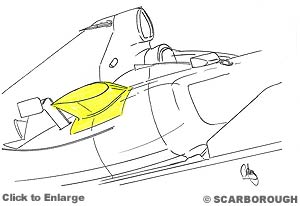 Fastest in the first Friday session and slightly lower in the second, the Friday preparations went well - aside from Rubens Barrichello spoiling a set of tyres by flat spotting the front one. Qualifying also went problem free, avoiding the rain and taking the front row.
Fastest in the first Friday session and slightly lower in the second, the Friday preparations went well - aside from Rubens Barrichello spoiling a set of tyres by flat spotting the front one. Qualifying also went problem free, avoiding the rain and taking the front row.
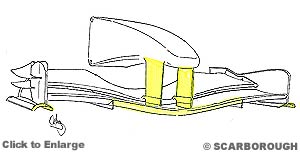 The shape of the wing is in contrast to the team's recent designs which have been flatter and making the majority of its downforce just outboard of the tusks. This set up is claimed to be less pitch sensitive but does limit maximum downforce and could be more roll sensitive. The new curved wing is the reverse of these qualities, trading more downforce for potential pitch sensitivity.
The shape of the wing is in contrast to the team's recent designs which have been flatter and making the majority of its downforce just outboard of the tusks. This set up is claimed to be less pitch sensitive but does limit maximum downforce and could be more roll sensitive. The new curved wing is the reverse of these qualities, trading more downforce for potential pitch sensitivity.
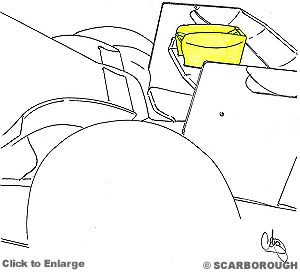 Renault also used a flexible plastic seal between the floor and the rear tyre to maintain the pressure difference above and below the floor. One of these was damaged in qualifying and had to be replaced in Parc Ferme on Fernando Alonso's car.
Renault also used a flexible plastic seal between the floor and the rear tyre to maintain the pressure difference above and below the floor. One of these was damaged in qualifying and had to be replaced in Parc Ferme on Fernando Alonso's car.
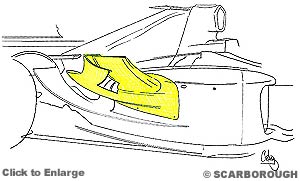 The BAR team arrived in Hungary after a bad week - where they seemed to have lost their key driver and also lost the appeal against the banning of their front brake system. (The FIA upheld the stewards' decision, claiming the system contravened an article in the rules concerning torque transfer between braked wheels. Notably, BAR have yet to publicly state how they feel the system could possible be legal.)
The BAR team arrived in Hungary after a bad week - where they seemed to have lost their key driver and also lost the appeal against the banning of their front brake system. (The FIA upheld the stewards' decision, claiming the system contravened an article in the rules concerning torque transfer between braked wheels. Notably, BAR have yet to publicly state how they feel the system could possible be legal.)
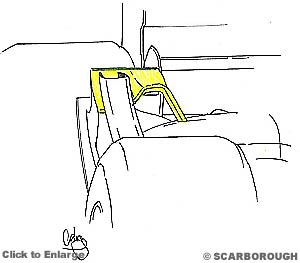 After a lacklustre Friday, with the team setting up the car and deciding on tyres, qualifying went perfectly, despite Jenson Button's dissatisfaction with his lap and having to have a Parc Ferme gearbox change Saturday evening.
After a lacklustre Friday, with the team setting up the car and deciding on tyres, qualifying went perfectly, despite Jenson Button's dissatisfaction with his lap and having to have a Parc Ferme gearbox change Saturday evening.
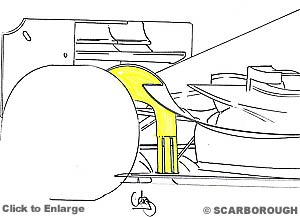 Friday saw Christian Klien take a trip off the track into the gravel. Qualifying saw the cars' compromised setup and fuel load cost the two drivers some grid places.
Friday saw Christian Klien take a trip off the track into the gravel. Qualifying saw the cars' compromised setup and fuel load cost the two drivers some grid places.
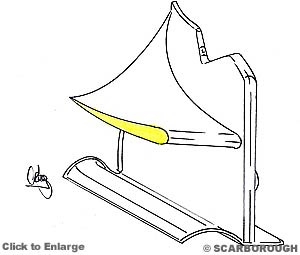 Detail visible on the new "B" spec of the car include the front wing endplate featuring a thicker flip up, echoing the double thickness flip up at the rear. Larger chimneys were also run to cope with the expected heat.
Detail visible on the new "B" spec of the car include the front wing endplate featuring a thicker flip up, echoing the double thickness flip up at the rear. Larger chimneys were also run to cope with the expected heat.
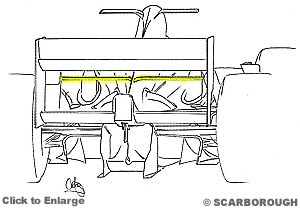 Appearing with a shelf wing between the rear wheels to add downforce at this slow track, the wing featured a small chord change as it meets the engine cover to reduce the unwanted vortices produced at the intersection.
Appearing with a shelf wing between the rear wheels to add downforce at this slow track, the wing featured a small chord change as it meets the engine cover to reduce the unwanted vortices produced at the intersection.
|
Contact the Author Contact the Editor |
Please Contact Us for permission to republish this or any other material from Atlas F1.
|
Volume 10, Issue 33
Articles
Formula What?
Bjorn Wirdheim: Going Places
Ann Bradshaw: Point of View
2004 Hungarian GP Review
2004 Hungarian GP Review
Technical Review: Hungary 2004
The Business of Winning
Stats Center
Qualifying Differentials
SuperStats
Charts Center
Columns
The F1 Insider
Season Strokes
On the Road
Elsewhere in Racing
The Weekly Grapevine
> Homepage |